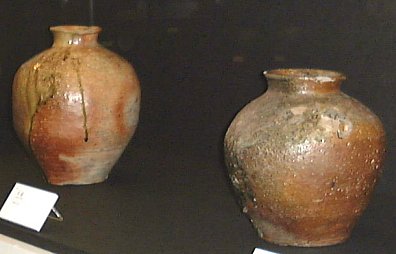|
Rediscovery and Revival of
the Beauty of Yakishime Stoneware
NOW SHOWING UNTIL NOVEMBER 25TH 2001
Shigaraki Ceramic Cultural Park Museum
2188-7 Chokushi, Shigaraki-cho, Kohga-gun, Shiga Japan
TEL. 81-748-83-0909 FAX. 81-748-83-1193
Admission: 600 yen for Adults
Closed Mondays
Togei no Mori (Ceramic Forest) is a large ceramic park in Shigaraki, Shiga Prefecture. To celebrate its tenth anniversary, the park is holding a grand look at the history of Shigaraki pottery that runs until November 25th.
Located just outside the center of this small potting town, the park consists of many buildings, one of which is the Museum of Contemporary Ceramics, where this excellent exhibition is being held. Yet upon entering the spacious hall one is not met by any modern pieces, but by 15th century pots that do exude a contemporary feel. Standing in front of the large tsubo (jars) with their bulbous forms, jewel-like natural glazes, and sparkling tsuchi-aji (clay flavor), one cannot help but feel in awe of their makers, and the beauty to be found in profound simplicity.
 |
Shigaraki pottery is thought to have begun in the waning years of the Kamakura period (1192-1333). Like it's close cousin Bizen, Shigaraki wares were originally daily utensils with tsubo, kame (wide-mouthed jars) and suribachi (grinding bowls) the main staples. Not until the tea masters of the Muromachi (1336-1568) and Momoyama periods (1568-1603) favored these natural wares did they develop into one of Japan's most loved ceramic styles. (Click here for a quick primer on Japan's main ceramic styles.) Gazing upon these gritty hand-formed chunks of clay, I wondered about those ancient tea masters and what shaped their aesthetics. These pots stirred up many questions in my mind, questions that may be impossible to answer. Often the questions are more important.
The exhibition shows many masterpieces of these early wares in the first section of the hall that highlights 'Medieval Kilns and the Birth of Shigaraki Ware.' Four other sections follow and they are:
- Latter Half of the Muromachi Period to Early Edo Period (1603-1868). From Utensil Wares to Artistic Tea Ceremony Wares (see below photo)
- Edo Period to Meiji/Taisho Periods (1868-1926)
- Modern Times ?The Revival of Old Shigaraki Ware
- Contemporary Artists in Shigaraki
In the Edo period, Shigaraki began to use glazes, most notably on tea jars used by the Shogun's family. After that, the town's ceramic output became an eclectic mix of items, from staple room-heating hibachi, to grenades, mailboxes, and much more. There is a small book on sale at the museum showing the mix of items.
The exhibition is also unique in that it shows the works of visiting artists who have participated in the 'Artists in Residence' program. From overseas we find Peter Voulkos, Ken Ferguson, Robert Brady, Peter Callas, Sandor Kecskemeti, and Jack Troy.
Naturally the works of some of Shigaraki's finest are on display and they include members of the Takahashi and Ueda families (who helped revive the traditions), Furutani Michio, Kanzaki Shiho, Otani Shiro, Sawa Kiyotsugu, and Kohyama Yasuhisa.
Other modern and contemporary Japanese potters works are by Rosanjin (1st photo below), Yagi Kazuo (2nd photo below), Tsuji Seimei, Tsujimura Shiro, Suzuki Goro, and Kakurezaki Ryuichi among others.
A beautiful catalog (below photo) was published and includes color photos of all the works on display as well as enlightening essays printed in both Japanese and English. These included Rediscovery and Revival of the Beauty of Yakishime* Stoneware by museum curator Otsuki Noriko; Shigaraki Project by museum curator Miura Hiroko; Memorandum - Firing with Guest Artists by Matsumoto Yoshisaburo; and A Short History of Wood Firing in America by Louise Cort. The catalog is for sale at www.japanesepottery.com.
* Yakishime means high-fired unglazed stonewares.
All in all a very worthwhile exhibit and one that all Shigaraki lovers should endeavor to see in person or in pictures.
by Robert Yellin, October 18, 2001
|